Interview: Julia Reichert and Steven Bognar
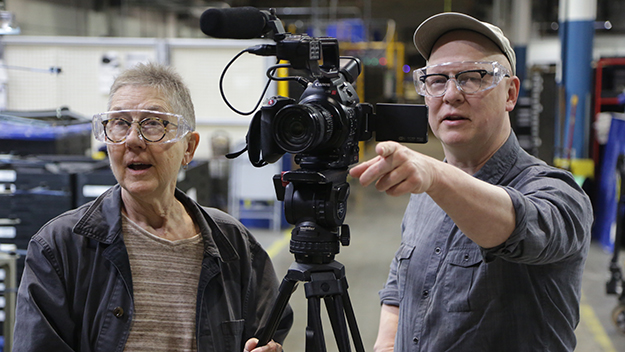
Julia Reichert and Steve Bognar shooting American Factory (2019)
When talking to Julia Reichert and Steve Bognar, issues of class and labor, of how class and labor shape and inform us as people, are often the main text, and otherwise subtext. This was the case last spring when I conducted the first of several extended conversations with Reichert and Bognar, stretching to the fall, in New York. The documentary team was since nominated for an Academy Award for their current film, American Factory, “an omnivorous account of the opening of the Chinese-owned Fuyao car windshield plant in Dayton, Ohio” [Film Comment September/October 2019]. It is their second nomination as a team (filming in the same building that they watched shutter 10 years prior with their 2009 Academy Award–nominated The Last Truck: Closing of a G.M. Plant), and Reichert’s fourth nomination overall (starting with Union Maids in 1976).
Before the audio recorder could even be switched on, Reichert and Bognar were discussing the resurgence of popularity of labor unions after decades of decline, which they equated with a parallel rise in women and workers of color within union leadership. They also asked questions of my own background as it pertained to these matters (my mother was a career-long member of the United Federation of Teachers, while my father worked for the U.S. Department of Labor). That in turn led to a question about Julia’s origins—which wound up comprising the entirety of this conversation, with Steve chiming in with perspective and additional questions of his own.
Read Eric Hynes’s essay on American Factory in our September-October 2019 issue.
How did everything start for you? What led you to filmmaking?
Julia Reichert: I didn’t go to film school. They didn’t have that. I grew up in a small town in southern New Jersey, on Exit 7, population 8,000 people—something like that. And I lived outside of town. My father had an acre and a tractor along with being a union man. He was a butcher. He didn’t finish eighth grade. He was very German—he didn’t speak English, ever. My mom was Irish. Her mom died of the influenza epidemic—she was raised by relatives and was more or less like a servant in their house. She took care of sick relatives, made the beds, stuff like that. Then 10 years after high school she went to nurse’s school. I didn’t know anyone who went to college in my world, except for our doctor and my teachers.
Were you interested in school?
JR: I loved learning stuff. I don’t know where it came from—my siblings didn’t share that. I was just super curious about the world and especially the natural world—the stars, the sea, the forest, the animals. We had no books in our house [but] my dad, who worked in a grocery store, knew I was interested in birds and nature and started bringing me home these little grocery store books. There was one about the stars, and it got me really interested in astronomy. I was a real nerd. I remember my dad would bring home his pay envelope with cash in it—about $130 a week, which was actually pretty good wages. Since he was in a union, he got three weeks off in the summer—total vacation, paid. For whatever reason my dad wanted to see the world, and we would get in the family car and travel, to Seattle, to Mexico, to Montreal for the World’s Fair. I got to sit in the front seat—my three brothers sat in the back.
I don’t know why but I had this driving curiosity, and I decided in my freshman year of high school that I wanted to go to college. I didn’t know how to do it, but there was this book, The Lovejoy’s College Guide, A through Z, it told you all about them. I started with A—Antioch. And the thing that appealed to me about Antioch was that you worked half the time. It’s a co-op school.
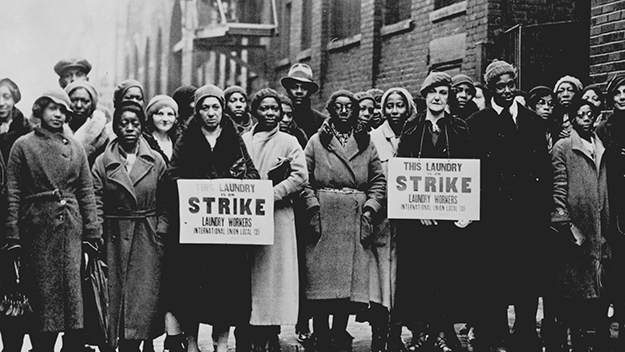
Union Maids (Julia Reichert, 2019)
You left campus to work?
JR: You left campus and you got a job somewhere in the world.
Why did that appeal to you? Why didn’t you want to immerse yourself in classes for four years?
JR: Because I wanted to see the world, I didn’t just want to sit and read books. Well, not that I didn’t want to read books, but since I was 14 I worked jobs at the shore during the summer, at Long Beach Island. I lied about my age and started working as a carhop at a soda and burger place, putting the trays on the car, “do you want fries with that?”—that kind of thing. I loved to work.
So Antioch let you work and study in equal measure.
JR: The summer before my senior year we were driving cross-country on Route 40, and Antioch was like 10 miles off, so I begged, “Can’t we just go see the campus?” It was dusk [when we arrived]. I remember I heard a live saxophone playing out of a dorm window, and [we passed] two women with long hair and guitars strung over their backs. I had never seen that. I also remember my dad going to the mailroom, looking at the open slots [with names attached]. “Lot of Jews here!” is what he said. “I don’t think you should go here.” I defied my parents. They didn’t give me any money to go to school—I had to save. I did get in. I got into Swarthmore, too. Antioch was 600 miles away, while Swarthmore was only around 40 miles away.
Farther away from home was better.
JR: Yeah. You know, I was a Republican going in. It was Goldwater versus Johnson, and my whole town was for Goldwater. I was like the dumbest kid going to Antioch. I didn’t know what a phallic symbol was, and everybody was talking about it in my literature class. So I asked my roommate, who was a daughter of Jewish Communists from Long Island. “What do they keep talking about? What is that?” She said, “It’s a prick!” There were many, many moments like that. I remember [orientation] in our hall when you sit around and you go, “Where are you from? What do your parents do?” Somebody’s parent was an engineer, another was a lawyer, another was a poet. My dad worked at a grocery store, and didn’t go to eighth grade, so I started lying immediately. I said that my dad is the manager of a grocery store. I lied about my class background right away, and kept going until a few years later when I discovered film and Marx.
And this was the mid-’60s?
JR: Yes, ’63, ’64.
That was a really important time for both film and politics. What are your memories of discovering film?
JR: [At Antioch] they had screenings of films, and I saw Night and Fog. I never knew there had been a Holocaust. That film opened my eyes to a period of history that I had not known about. I can still see those images. I saw Frederick Wiseman’s Titicut Follies, [felt] the power of those close-ups, of those verité images where you’re actually there. It wasn’t like I thought, “I want to be a filmmaker,” exactly, because there were no women who were filmmakers. We were still in the era where even if you went to college you probably ended up in some clerical position, or maybe as a teacher.
Did you have a major?
JR: Yes, education. Media education, actually, since there was no filmmaking major. But first [before declaring a major], I decided to go to Guanajuato, Mexico to work on a language program where I polished up my Spanish. Every weekend I went to archeological sites—I had a guy friend there whose mother was an archeologist. Then I stayed in Mexico and just traveled around, hitchhiking, which I can’t believe I did. I stayed in Oaxaca, Merida, Isla Mujeres, for weeks at a time at each one, looking for someone to hire me at an archeological dig, but that never happened. So I was in Mexico, dropped out of school, and psychologically it was very hard to handle. I was lying about myself—when you’re 20, you’re very unstable anyway.
Then I went to the Summer of Love. I didn’t know it was going to be the Summer of Love—I wasn’t like, oh, I’m gonna hitchhike out to the Summer of Love in California and listen to “Like a Rolling Stone” on the radio—all these things were just happening. Yet that song did play constantly on the way out. I can still totally hear it. [Hums tune] That’s Al Kooper on the organ, who apparently didn’t even know how to play the organ very well, which was like all of us. I was there at Golden Gate Park with The Grateful Dead passing around huge tubs of salad, big as that couch, with people plunging their hands in and just eating it. They were not The Grateful Dead as we know them now, they were just these hairy young guys with big smiles on their faces—tripping, I’m sure.

Growing Up Female (Julia Reichert and Jim Klein, 1971)
At what point during all of this did you stop being a Republican?
JR: Oh, that changed right away. My roommate talked to me all night every night. She would ask me why I believed what I believed and I realized I didn’t know. And she helped fill me in. Pretty soon I was going door to door for Lyndon Johnson. So I dropped out, then moved to New York to live on the Lower East Side, which then was a very cheap place to live. It was very Polish, Romanian, Latino, there was a bathtub in the room where you cook your breakfast, and roaches sleeping on the floor. I painted the walls black because that’s what you did. I had friends who worked at the Fillmore East. They would open the side doors and you would see everybody. I went to a party with Janis Joplin, sat right next to her. I was a barmaid on the Upper West Side, at the West End Bar during the Columbia Revolt. I was serving the students beers and they were talking about what they’re doing. I wanted to talk with them but they were treating me like a waitress. It hit me really hard that they did not consider me their equal. I was serving them beer and burgers, and I was not one of them, even though I had just been at Antioch, and traveled all through Mexico. Class differences come jumping out at you all the time. And I was a woman—they were mostly guys.
Later I got a job as a receptionist at a photo lab—by then I wanted to be a photographer—and some of New York’s greatest photographers would come in and deliver their prints, and I’d have to be friendly and write down everything, while in the back were all these men doing real printing. I would go back and look—they were masters at it. One block away was the Museum of Modern Art, and it turned out that every Wednesday from noon to 1 they had a film screening, which was exactly for people like me who got an hour lunch break. And it was free. So every noon I would go to the corner deli, order a tuna sandwich—it was always tuna—cut it in half, put it in a bag, and take it to the museum. I sat in the back, because tuna was smelly and unwrapping the package was like [imitates crunching noises]. The film had already started, because it would be 10 after 12, and I would have to be back by 1, but I would watch whatever was on the screen. It was mostly experimental shorts. I think I saw Meshes of the Afternoon there, and that the director, Maya, was a woman—that clicked for me somehow.
It was one of those little steps on the way to being a filmmaker, seeing these films. A working-class person with poor education who’s given a camera, which my dad did—a little Argus Rangefinder when I was 13. We were working-class kids, but me and my brothers were given a chance to use our creative selves. We had an opening, someone who gave us something, or told us something, or found something, like the museum.
The word that always comes to mind, in terms of my experience, is “permission.” You come from a place where such ways of thinking and living are inconceivable, but somewhere along the way you’re either given or give yourself permission to enter, or to try.
Steve Bognar: Maybe you disagree with this statement, Julia, but inherent in you is that you never ask for permission. One of the things about you that has been so inspiring for me is that you never accept that things are not possible. There’s something in you that will find a way.
JR: I think that’s the ’60s, to challenge authority. You have a set of values that you measure society against—equality for all, that women and people of color should have an equal position, or that we shouldn’t be invading other countries. And if things don’t match up, you go with your values and fight. But I think Eric is right. When you’re little, when you’re young—and it’s especially true for women from that era—there are a lot of things we did not have permission to do.
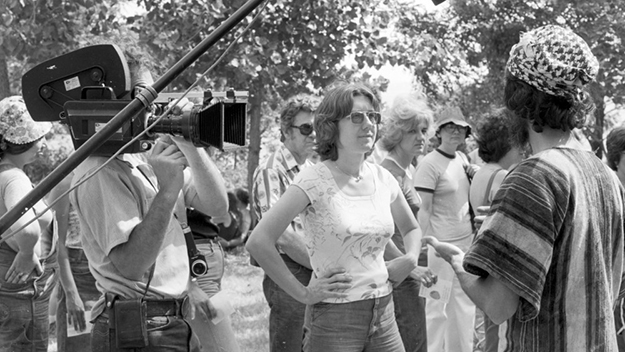
Julia Reichert shooting Seeing Red (Julia Reichert and Jim Klein, 1983)
Yet you gave yourself permission to think of yourself in a certain way.
JR: Yeah. Why is that? I was sort of a loner. Maybe that’s why. Being a geeky kid who loved to study. I got glasses when I was 10.
As in, other people’s perception of you actually allows you to pursue a true version yourself? Like, if you’re the geeky glasses kid, nobody’s going to expect you to be the star athlete.
JR: Or the pretty girl. Because that’s what girls were all about: who’s the prettiest?
And you were a tomboy.
JR: I was a total tomboy. Which had something to do—now we know—with some kind of gender fluidity thing, and I’m probably somewhere on the spectrum. Back then, there were girls and there were boys, and that was that. But I didn’t really fit into that. We didn’t have words for it, other than tomboy, which was negative. Now it’s kind of positive.
Being a tomboy was okay up to a certain age, but then you had to stop being a tomboy.
JR: Don’t forget I grew up around boys. My mom worked 2 to 11, so my dad was home for dinner and my mom wasn’t. I had three brothers and we all ran around like a gang. We ran into the woods and had gang fights, and there were all boys on the other side because the girls were playing with dolls. I never got why that was so interesting.
So you lived in New York, saw films at MoMA, and then wound up back at Antioch?
JR: A year and a half later I came back from being dropped out, and we had a film teacher! Which we’d never had. So I signed up for it in the fall of ’68 and Jim Klein—Jimmy—was in the same film class. And the teacher, David Brooks, really changed my life.
SB: David Brooks was a New York experimental filmmaker in the realm of Jonas Mekas and other folks, and he got this teaching job at Antioch. He died in a car accident when he was just 24.
JR: He worked at the Film-Maker’s Coop. He had already won [at] Ann Arbor [film festival] twice for best film, and he got this teaching job at Antioch. So Jimmy and I are in this film class and we get a movie camera. Mine was a little windup, like a Bolex, and you could shoot all kinds of stuff and learn to hold your shots. It was all experimental film. On the first day of class, there’s a huge room of people, and everybody’s very excited about this young film teacher coming from New York City, and he shows us a Stan Brakhage film, one of the longer ones, maybe Anticipation of the Night? David turns on the lights and says, “What did you see?” And nobody answers. Nobody has any idea what to say. Somebody raised their hand and said, “Someone trying to figure out what you can do with a camera?” David says, “Okay, we’re gonna watch it again.” The class was very small after that day, but I stuck with it. Maybe 10 or 15 of us [signed up for] the next semester. This time it was Film Watching. We watched 30 Howard Hawks films. That’s all we did. It was the auteur theory, [following these] threads of imagery and thoughts and themes. We would meet nine hours, once a week, watch two Howard Hawks films, and cook dinner together. It was so great. That was my film school, and then David got killed.
You know when you’re 19 or 20, one of those very solemn things you do at someone’s funeral is [proclaim that] you’re gonna continue the work? I did that. I had been making a documentary for David’s class, which he was very encouraging of. It was called Going to Town, and was about the aging-out of farmers and their kids not wanting to [continue farming]. I was drawn to documentary because of my interests in radio and photography. I did a lot of radio documentaries, and learned to edit and to interview that way, and mix music in—all those skills of filmmaking I learned through radio, where it’s cheap. Then Growing Up Female was my senior project.
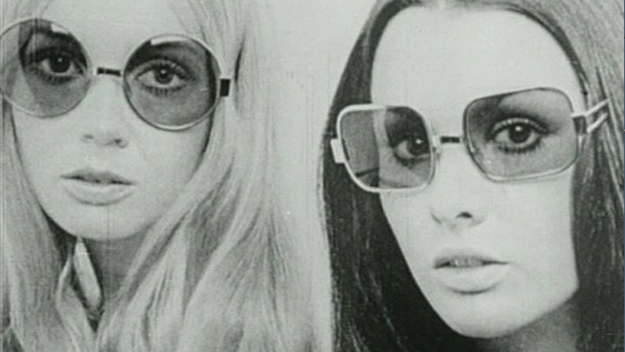
Growing Up Female (Julia Reichert and Jim Klein, 1971)
Had you already developed a language for approaching the film in terms of form, length, the handling of subject? Or was it organic to the making?
JR: I would say a lot of it was just what we thought made sense. I would cite two films. One is a film I saw back during my last year in high school, Harvest of Shame, from Edward R. Murrow and CBS Reports. It was about migrants, and it was shown on Thanksgiving night. The other was 16 in Webster Groves by Arthur Barron, a big TV film about being 16 and living in Webster Groves, Missouri, and it was about what the lives of the kids were like, seated around the table with their parents at dinner. It was like an essay, almost a polemic. Growing Up Female is an essay film, though we didn’t use that word—didn’t know it. Or a polemic—I also didn’t know that word. It’s trying to make a point, and I think it does so very well. What has become of the American woman? Where do we find her? Where is she in all this?
But how about the idea of observing a series of women, and introducing them sequentially?
JR: That occurred to me on New Year’s Eve. I was on the phone with a friend and said, “We should follow women of different ages and just see what their life is like.” It’s a really simple idea. Following girls in nursery school up to the oldest we could imagine, which was 34. Once you’re married with kids—that’s it, there’s nothing more to say. So that’s the oldest. One was 11 or 12, and we got a tomboy, probably because I related to that, another at 16, on the verge of considering a future, maybe college. Then two women at 21. We only planned on one, but these two women worked at the same place and one was a white clerical worker and the other was an African American factory worker and we thought: this is really interesting in terms of race.
You were already allowing reality to complicate your original idea.
JR: That’s true. And then the housewife. That was it.
To defend your stopping with the housewife, it is called Growing Up Female, not Grown Up Female.
JR: That was not our original title. Jonas Mekas wrote our first article we ever got in the Village Voice about what was originally called As Six Become One, and he basically railed against filmmakers giving their films obscure titles. So we changed it to Growing Up Female, which was a much better title.
The Kartemquin films from that era have a similar quality of observational, character-rich filmmaking with a polemical element. Each film finds a different center between those two poles.
SB: It’s the era in direct cinema when the through-line was observational but also the filmmakers permitted themselves to raise questions overtly. It had roots in the social issue documentary.
JR: I certainly thought of film as a tool for social change. I did not think of it as a personal expression. I had made those films, experimental films, in college, whereas this was a tool for the movement. It was 1970, when the women’s movement in the Midwest was just beginning to percolate. I was in one of the first consciousness-raising groups that happened at Antioch. Five of us met for six months before [anyone else showed up]. The Miss America pageant protest had happened, and I think NOW and Ms. magazine had been founded. Meanwhile the antiwar movement was a huge group—all men, all smoking Pall Malls. They would all talk, talk, talk, but if you raised your hand timidly, as a woman you might get called on. The antiwar movement was very important, and of course I went to the marches and everything, but it was very male-dominated.
When the women’s movement ideas came along, we started challenging our comrade men for taking up all the space and making all the arguments, for making us carry the leaflets. We wanted to help the women’s movement grow. So we used film, or radio, interviewed people, mixed in music.
SB: In radio, there was no NPR back then, so you could air something on the Antioch Radio Station at the time and a thousand people might hear it.
JR: But there was Newsreel.
SB: Newsreel was a radical filmmaking collective.
JR: People don’t know about this anymore. It was so important.
SB: They were mostly New Yorkers, weren’t they?
JR: No, they were all over the country! There was San Francisco Newsreel, there was Boston Newsreel. There ended up being Cincinnati Newsreel, Yellow Springs Newsreel, Detroit Newsreel. I don’t know where they all went. But during that era, everyone would cite Newsreel. It was male-dominated, although women started rising up within it. Newsreel would take films to high schools, factories, neighborhoods, these very left-wing films. There’s one about the Columbia Revolt, films about the war in Vietnam, films from China. That was how our film was gonna get out—we took it to Newsreel. They said it was a bunch of bourgeois crap, much to our shock.
Was it because it was about women, about domestic spaces?
JR: No, it was more of a style. It doesn’t call for revolution, doesn’t mention socialism, doesn’t mention patriarchy.
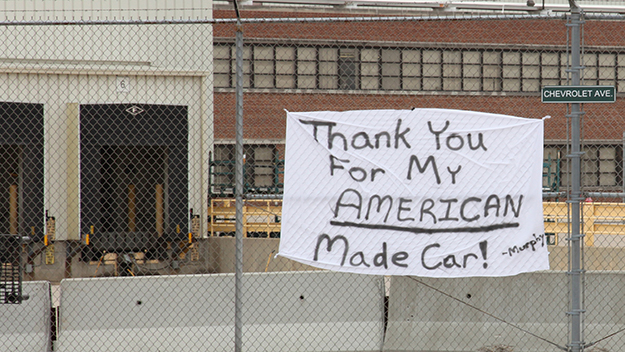
The Last Truck: Closing of a GM Plant (Steven Bognar and Julia Reichert, 2009)
It’s not polemical enough.
JR: Yeah. We made it so that people I grew up with—my mom, the people on my block, the people I went to school with—could watch it and feel like it was about them, then by the end realize there’s something really wrong here. It’s a “step one” film. I always felt my mother was over my shoulder in those early films. If she’s not gonna get it, it’s not gonna be in our films.
It seems that even though you venerated Newsreel and the work they produced, you had already identified that style as too limiting. You didn’t just want to make films for your comrades.
JR: In that moment, yes. Newsreel women made a film—it came out a year or so after Growing Up Female—called The Woman’s Film. It was widely distributed, and it mentioned socialism and it mentioned the class struggle, it was much more overtly anti-capitalist, pro-socialist. But I didn’t start there. I figured taking little steps was the best we could do as an organizing film—and it was an organizing film. Growing Up Female was 100 percent used to grow the women’s movement. No question about it, and that also solidified my idea that films could change the world.
And you got enough evidence to think that a difference could be made?
JR: A thousand percent. I’ll give you two pieces of evidence. One is me, myself. I traveled around on a bus with a 16mm print to Ohio, Cleveland, Boston, Pittsburgh, Washington, D.C., Oklahoma, Tallahassee—all the places where I got invited, carrying this one print. There were a couple of women who I knew from the women’s movement in Cleveland, and they somehow got a projector from the high school to watch, and they would be like, “Oh man, I gotta take it to my high school. Let’s arrange a screening in a couple days.” I ask them, “Do you know anybody in Pittsburgh? Do you know anybody in Athens, Ohio?” And they say, “I do, I’ll call him!” And I take down everybody’s address. This is literally what happened. So I had to make a second print.
Another example: Athens, Ohio. We have a screening and all these people come—men and women. We start having discussion, and women start saying, “Yeah, that happened to me!” and the men would stand up and say, “You gotta make a film like this about men. Men are oppressed, too!” and the women would shout at them, “Shut up! Sit down!” Because men would get up and start dominating, as they’re used to doing, right? But the men would say, “We’re not gonna shut up!” And the women would say [among themselves] we wanna talk about this, and finally some woman said, “There’s a room down the hall that we can use. All the women, let’s go down there. We’ll close the door, and no men are allowed.” I didn’t suggest it. We went down the hall and then we really started talking. Then I got a postcard, like a month later, from Athens saying, “We kept meeting after your film. We met the next week, and the next week, and we’re starting the Athens Women’s Center.”
And that wasn’t the only time that happened. The orders started pouring in. Mostly from Radcliffe, Barnard, Brandeis, big state schools. A year or so later, we start getting smaller state schools in the Midwest. A year later, we started getting Catholic schools. Then we started getting orders from the South. Talk about the women’s movement spreading! We had 30 prints out, which we would take back and forth to the post office in Yellow Springs. All that led me to believe that you have to get involved in distribution—you cannot just hand the film off to somebody who may not have your values. And that your film can make a difference.
Eric Hynes is a journalist and critic, and curator of film at Museum of the Moving Image in New York.







